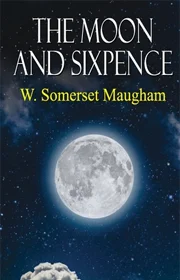
“The Moon and Sixpence” follows the journey of Charles Strickland, a man who leaves his family and job to pursue his passion for art. Inspired by the real-life artist Paul Gauguin, Strickland travels to Paris and Tahiti, disregarding societal norms. The novel explores the conflict between traditional morality and the unconventional life of an artist, delving into themes of sacrifice and the pursuit of personal fulfillment. The story unfolds as a thought-provoking exploration of the artist’s struggle and the impact of art on both the creator and society.
Read The Moon and Sixpence Flipbook:
Listen to The Moon and Sixpence Audiobook:
Title:The Moon and Sixpence
Author: W. Somerset Maugham
Genre: Fiction
Publication Year: 1919
Setting: Primarily in London and Paris
Plot Summary:
• Inspired by the life of Paul Gauguin, the story follows Charles Strickland, a middle-aged stockbroker, who abruptly abandons his family and career to pursue his passion for art.
• Strickland travels to Paris and later to Tahiti in his quest for artistic fulfillment, ignoring societal norms and personal relationships.
• The narrative explores the conflict between conventional morality and the unconventional, individualistic life of an artist.
Themes:
• Exploration of the artist’s commitment to creative expression at the expense of societal expectations.
• Critique of bourgeois values and the pursuit of material success.
• Examination of the impact of art on both the creator and society.
Characterization:
• Charles Strickland: The enigmatic protagonist driven by an intense desire for artistic authenticity.
• Other characters serve as observers and commentators on Strickland’s unconventional choices.
Style:
• Maugham’s narrative is straightforward, reflecting a mix of observational and reflective storytelling.
• The language is accessible, making it relatable to a broad audience.
Legacy:
• “The Moon and Sixpence” is considered one of Maugham’s most notable works, showcasing his skill in exploring complex human motivations.
• The novel has inspired various adaptations and discussions on the nature of art and the artist’s life.